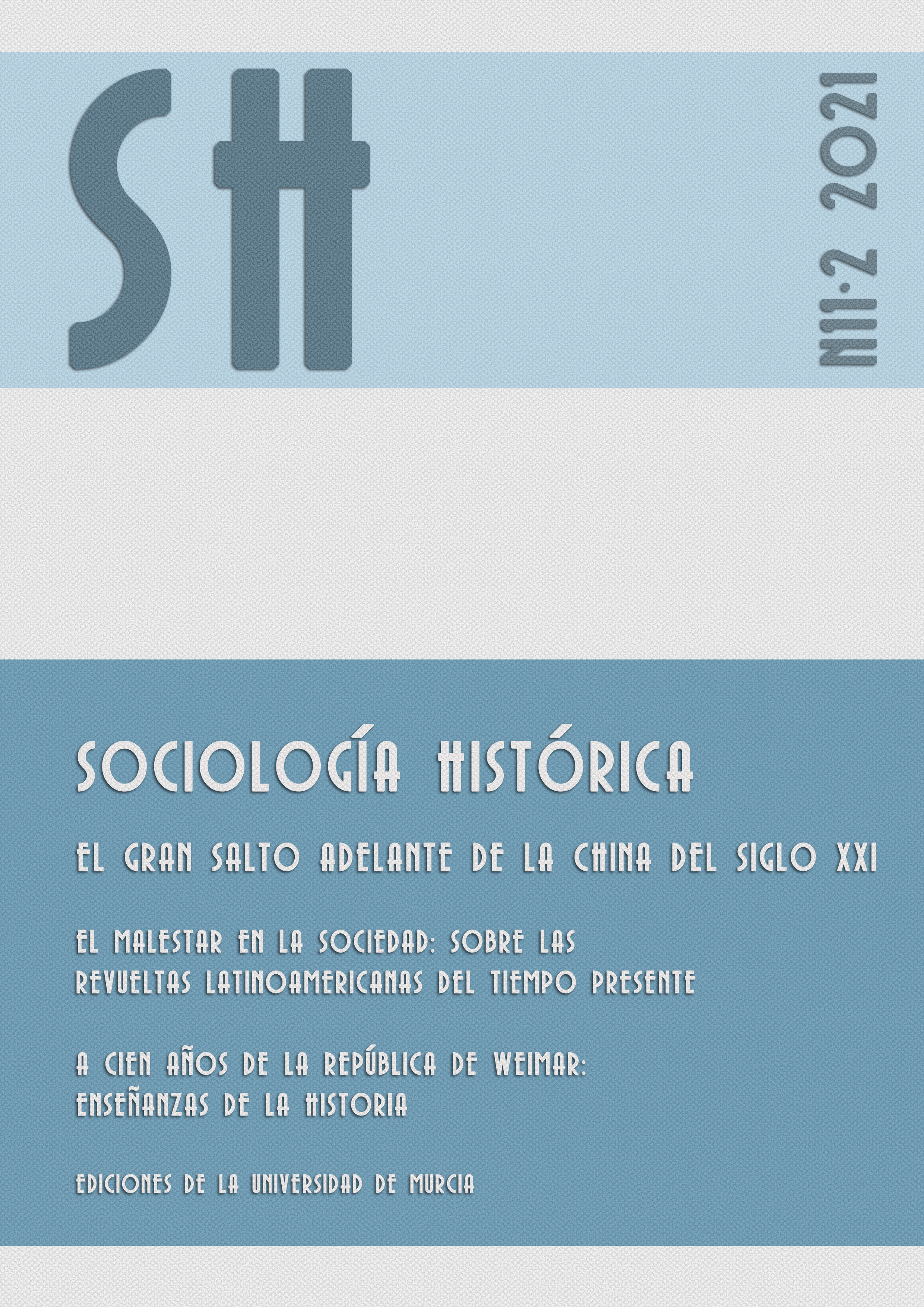Civilization Places: The case of Public Toilets in Nanjing, China
Abstract
The article takes public toilets in the city of Nanjing, China, as a case study to analyze the concept of civilization from a spatial and praxeological perspective. Applying an anthropological view ―employing descriptions and ethnographic vignettes– the author links the local logics of civilization, particular to a historical and cultural Chinese context, with the (ideo)logics of global capitalism, revealing a struggle of positions and a set of contradictions that are a clear limit to the hegemonic notion of civilization and, maybe even, to global capitalism itself.
Downloads
References
AGAR, M. (1991): “Hacia un lenguaje etnográfico”, en El surgimiento de la Antropología posmoderna, Barcelona: Gedisa (pp. 117-140).
ANAGNOST, A. (2004): “The Corporeal Politics of Quality (Suzhi)”, Public Culture, 16 (2), pp. 189-208. Accedido desde https://www.muse.jhu.edu/article/169125.
AUGÉ, M. (2000): Los no-lugares: Espacios del anonimato, Barcelona: Gedisa.
BOURDIEU, P. (2008): El sentido práctico, Madrid: Siglo Veintiuno Editores.
CHAN, K. W. (2012): “Crossing the 50 Percent Population Rubicon: Can China Urbanize to Prosperity?”, Eurasian Geography and Economics, 1 (53), pp. 63-86. https://doi.org/10.2747/1539-7216.53.1.63
CHANCE, N. A. (1991): China’s Urban Villagers: Changing Life in a Beijing Suburb, Orlando: Harcourt Brace College.
CHEN, N. N., CLARK, C. D., GOTTSCHANG, S., y JEFFERY, L. (eds.) (2001): China urban. Ethnographies of contemporary culture, London: Duke University Press.
CHENG, S., LI, Z., UDDIN, S. M. N., MANG, H.-P., ZHOU, X., ZHANG, J., ZHANG, L. (2018): “Toilet revolution in China”, Journal of Environmental Management, 216, pp. 347-356. http://dx.doi.org/10.1016/j.jenvman.2017.09.043
DAI, W. (2018): “Seats, Squats, and Leaves: A Brief History of Chinese Toilets”, Sixth Tone. Consultado: 12 de enero del 2019 (https://www.sixthtone.com/news/1001550/seats%2C-squats%2C-and-leaves-a- brief-history-of-chinese-toilets)
DUPONT, H. L. y BEAN, W. B. (1978): “Sir John Harington, Thomas Crapper, and the flush toilet”, South Med Journal, 71 (9), pp. 1145-1147. DOI: 10.1097/00007611-197809000-00026
ELIAS, N. (1987): El Proceso de la civilización: Investigaciones sociogenéticas y psicogenéticas, Madrid: Fondo de Cultura Económica.
FOLCH, D. (2016): “Song Cities and Mongol Conquest”, The European Discovery of China. Consultado: 12 de enero del 2019 (https://www.futurelearn.com/courses/european-discovery-china/2)
FRIEDMAN, S. L. (2004): “Embodying Civility: Civilizing Processes and Symbolic Citizenship in Southeastern China”, The Journal of Asian Studies, 63 (3), pp. 687- 718. https://doi.org/10.1017/S0021911804001688
GAETANO, A., y JACKA, T. (eds.) (2004): On the Move: Women and Rural-to- Urban Migration in Contemporary China, Portland: Columbia University Press.
GEISLER, T. C. (2000): “On Public Toilets in Beijing”, Journal of Architectural Education, 53 (4), pp. 216-219. https://doi.org/10.1162/104648800564626
GERNET, J. (2005): El mundo chino, Barcelona: Crítica.
GOFFMAN, E. (1990): The Presentation of the Self in Everyday life, London: Penguin books.
HANH, H. P. (2018): “Approaching Civilization from an Anthropological Perspective: The Complexities of Norbert Elias”, Anthropology and Civilizational Analysis, New York: Suny Press, pp. 35-52.
HARVEY, D. (2017): El cosmopolitanismo y las geografías de la libertad, Madrid: Akal.
HOU, Y., WANG, K. y LIU, F. (2017): “Quanguo gongxin gaijian luyoucesuo 6.8 wanzuo zhuanjia: cesuogemingxi wushi zhi ju [Construcción en todo el territorio nacional de un total de 68.000 nuevos baños públicos en zonas turísticas bajo el plan: Concretando la Revolución de los Lavabos]”, Zhongguo caijing. Consultado: 15 de noviembre del 2019 (http://finance.china.com.cn/industry/20171120/4443017.shtml)
LARREA, C. (1997): La cultura de los olores. Una aproximación a la antropología de los sentidos, Quito: Abya-Yala.
LEIBOLD, J. (2007): Reconfiguring Chinese Nationalism. How the Qing frontier and its indigenes became Chinese, New York: Palgrave Macmillan.
MA, R. (2003): “Population Growth and Urbanization” en Understanding Contemporary China, London: Lynne Rienner (pp. 227-254).
MORENO, I. (2011): “Los papeles posibles de la antropología en tiempos de glocalización”, Revista Andaluza de Antropología, 1, pp. 2-25. http://dx.doi.org/10.12795/RAA
ROMERO, A. (2018): “From Process of Civilization to Policy of Civilization: A holistic review of the Chinese concept wenming”, (Con)textos, 8, pp. 1-14. Accedido desde http://revistes.ub.edu/index.php/contextos/article/view/27293/28304
STANWELL-SMITH, R. (2010): “Public toilets down the drain? Why privies are a public health concern”, Public Health, 124, pp. 613-616.
THOMAS, N. (2018): “China’s ‘Toilet Revolution’ Shows Us That Politics Still Matters in the Xi Era”, MacroPolo. Consultado: 15 de junio de 2020 (https://macropolo.org/chinas-toilet-revolution/)
TOMBA, L. (2014): The Government Next Door: Neighborhood politics in Urban China, London: Cornell University Press.
ZAVORETTI, R. (2017): Rural origins, city lives: class and place in contemporary China, Seattle: University of Washington Press.
ZAVORETTI, R. (2010): “Ciudades chinas: ¿Un ‘escenario de riesgo’? Desigualdad, malestar social y la política del esencialismo cultural”, CIDOB d’Afers Internacionals, 89, pp. 103-125. Accedido desde https://www.jstor.org/stable/25746490
-
Abstract356
-
pdf (Español (España))294
Copyright (c) 2022 Historical Sociology

This work is licensed under a Creative Commons Attribution-NonCommercial-NoDerivatives 4.0 International License.
Las obras que se publican en esta revista están sujetas a los siguientes términos:
1. El Servicio de Publicaciones de la Universidad de Murcia (la editorial) conserva los derechos patrimoniales (copyright) de las obras publicadas, y favorece y permite la reutilización de las mismas bajo la licencia de uso indicada en el punto 2.
2. Las obras se publican en la edición electrónica de la revista bajo una licencia Creative Commons Reconocimiento-NoComercial-SinObraDerivada 4.0 España (texto legal). Se pueden copiar, usar, difundir, transmitir y exponer públicamente, siempre que: i) se cite la autoría y la fuente original de su publicación (revista, editorial y URL de la obra); ii) no se usen para fines comerciales; iii) se mencione la existencia y especificaciones de esta licencia de uso.
3. Condiciones de auto-archivo. Se permite y se anima a los autores a difundir electrónicamente las versiones pre-print (versión antes de ser evaluada) y/o post-print (versión evaluada y aceptada para su publicación) de sus obras antes de su publicación, ya que favorece su circulación y difusión más temprana y con ello un posible aumento en su citación y alcance entre la comunidad académica. Color RoMEO: verde.










